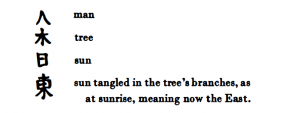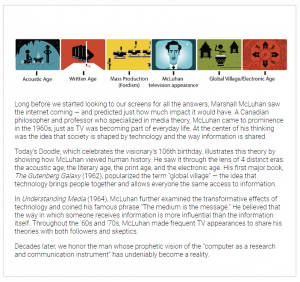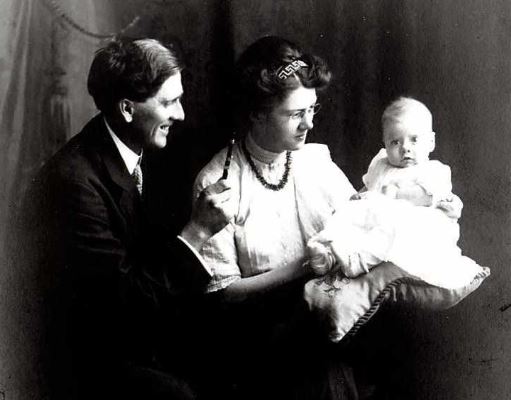Tradition (…) cannot be inherited, and if you want it you must obtain it by great labour. It involves in the first place the historical sense (…) which is a sense of the timeless as well as of the temporal and of the timeless and the temporal together (…) And it is at the same time [at the same time!] what makes a writer most acutely conscious of his place in time, of his own contemporaneity. (Eliot, Tradition and the Individual Talent, 1919, frequently cited by McLuhan beginning with ‘Eliot’s Cubist Aesthetic’ in 1947)
‘Change’ is (…) generally believed a single-gauge track. It is not a single-gauge track at all. It is a multitudinous field of tracks… (Lewis, Paleface, 1929, 122)
*
Loose note found in McLuhan’s copy of the University of Toronto Quarterly, 19:2, January 1950:
We can only correct the bias of the present time by coming to know it is a time, not the time.
*
‘The Analogical Mirrors’, 1944:
He must overcome and be overcome at the same instant — at every instant.
‘The Aesthetic Moment in Landscape Poetry‘, 1951:
the Symbolists [took] aesthetic experience as an arrested moment, a moment in and out of time, of intellectual emotion for which in their poems they sought the art formula by retracing the stages of apprehension which led to this moment.
‘Joyce, Aquinas, and the Poetic Process’, 1951:
The moment of arrest is an epiphany, a moment not in time’s covenant, and it is by the bringing of complex perceptions to a focus in such moments that the minotaurs of the labyrinths are always overcome.
‘Wyndham Lewis: His Theory of Art and Communication’, 1953
“The world of the ‘pure Present’ of the Classical Ages is obviously the world that is born and dies every moment.”
‘Joyce, Mallarmé and the Press’, 1954:
That manipulation of a continuous parallel between modern Dublin and ancient Ithaca which Mr. Eliot has noted as the major resource of Ulysses was a transfer to the time dimension of a “double-plot”…
‘Space, Time, and Poetry, Explorations 4, 1955:
Shakespeare’s Sonnet 73 begins:
That time of year thou mayst in me behold
When yellow leaves, or none, or few, do hang
Upon those boughs which shake against the cold,
Bare ruined choirs, where late the sweet birds sang.
Here the “time of year” (…) is visualized swiftly in three different ways in the second line and then a fourth and fifth time in the third and fourth lines.
‘New Media in Arts Education’, 1956, on Rimbaud’s poem “Dimanche”:
The organization of experience here is orchestral or acoustic rather than visual. Yet the various units of experience are visualized. There is a landscape, but it includes more than one space in its space and more than one time in its time. It is a simultaneous order such as music readily offers. A merely visual landscape, however, can offer only one space at one time.
Coleridge as Artist, 1957
The Coleridgean awareness of the modes of the imagination as producer represents an enormous extension of the bonds of human sympathy and understanding, socially and historically. Coleridge wrote to Wordsworth On the Night After His Recitation of a Poem On the Growth of An Individual Mind:
The truly Great
Have all one age, and from one visible space
Shed influence!
This has more than a neo-Platonic doctrinal interest at the present time when the instantaneity of communication between all parts of the world has brought into involuntary juxtaposition the whole diversity of human cultures. What century is it today in Peking or Jerusalem or Moscow? Yet the very speed of communication between these entities so discontinuous in space, time, and experience makes for a simultaneity in which lineal history is abolished by becoming present.
The Little Epic, late 1950s:
Language itself and every department of human activity would in this view be a long succession of ‘momentary deities’ or epiphanies. And such indeed is the view put forward in the Cratylus of Plato: I believe, Socrates, the true account of the matter to be, that a power more than human gave things their first names, and that the names which are thus given are necessarily their true names. In this way etymology becomes a method of science and theology. William Wordsworth called these momentary deities ‘spots of time’, Hopkins called them ‘inscapes’ and Browning built his entire work on the same concept of the esthetic of the ‘eternal moment’.
Tennyson and the Romantic Epic, 1960:
Looking back from the nuclear age it is easy to recognize the pattern of ‘total field’ forming in the concern with totality of implication in the aesthetic moment, or spot of time.
Tennyson and the Romantic Epic, 1960:
Digression is the principal artistic device by which little epic exists. The reason for this is quite simple. To transcend time one simply interrupts the natural flow of events.
The Gutenberg Galaxy, 1962, p 14 (citing Georges Poulet):
“For the man of the Middle Ages, then, there was not one duration only. There were durations, ranked one above another, and not only in the universality of the exterior world but within himself, in his own nature, in his own human existence.”
The Gutenberg Galaxy, 1962, p 249-250:
James Joyce certainly thought he had found in Vico a philosopher who had some better cultural awareness than those moved by the “Cartesian spring.” And Vico, like Heidegger, is a philologist among philosophers. His time theory of “ricorsi” has been interpreted by lineal minds to imply “recurrence.” A recent study of him brushes this notion aside. Vico conceives the time-structure of history as “not linear, but contrapuntal. It must be traced along a number of lines of development“. For Vico all history is contemporary or simultaneous, a fact given, Joyce would add, by virtue of language itself, the simultaneous storehouse of all experience. And in Vico, the concept of recurrence cannot “be admitted at the level of the course of the nations through time”: “The establishment of providence establishes universal history, the total presence of the human spirit to itself in idea. In this principle, the supreme `ricorso’ is achieved by the human spirit in idea, and it possesses itself, past, present, and future, in an act which is wholly consonant with its own historicity.”
Understanding Media, 1964, p 152:
plurality-of-times succeeds uniformity-of-time
The Medium is the Massage, 1967, p 63:
Ours is a brand-new world of allatonceness. ‘Time’ has ceased, ‘space’ has vanished. We now live in a global village…a simultaneous happening.
‘Education in the Electronic Age’, 1967:
Everything happens at once. In the new painting and the new art and the new literature, it is a happening. A happening is an all-at-once situation. There is no story line. We are all engaged in a happening; everything happening at once. That is what a happening is. It is not one thing at a time but everything at once.
Retrieval-Retribal in the Electronic Age, 1967
this phrase that I wrote on the board, ‘the heliotropical (k)not time’, refers to the TV image as a sun radiating at the viewer, helio tropical, turning us all toward the eastern sun; (k)not time, meaning all times are simultaneous now. All cultures are simultaneous. There is no time that fills our focus. Many times, all times, just as in a dream, at night, nighttime. All that we ever were, collectively, is now simultaneous. There is no longer an historical time, there is only a (k)not time left to mankind or a nighttime or a dream world. The old visual time, like clock time, is fragmented and segmented into little bits. That is what we call time, time marches on — but [now we perceive time as] also backwards, sideways, up and down. But to the print man, time simply matches on, there isn’t any other direction possible for the print man. But for the ear man, time moves in all directions simultaneously.
Through the Vanishing Point, 1968, p 55:
If the three-dimensional illusion of depth [in Western European art] has proved to be a cul-de-sac of one time and one space, the two-dimensional [in Eastern art] features many spaces in multileveled time.
Through the Vanishing Point, p 103:
The Shakespearean moment (“that time of year”) includes several times at once…
Through the Vanishing Point, p 195:
[Dylan] Thomas’ poetry is a chamber simultaneously echoing with many times.
Through the Vanishing Point, p 221:
In an electronic world where all-at-onceness is inevitable and normal, we have rediscovered an affinity for the discontinuity of Oriental art and expression
Counterblast, 1969
the omnipresent ear and moving eye
‘Electric Consciousness and The Church’, 1970:
we live in post-history in the sense that all pasts that ever were are now present to our consciousness and that all the futures that will be are here now. In that sense we are post-history and timeless. Instant awareness of all the varieties of human expression constitutes the sort of mythic type of consciousness of ‘once-upon-a-timeness’ which means all time, out of time.
‘Theatre and the Visual Arts’, 1971:
Without static you have no continuity.
Culture is our Business, 1972 Introduction:
The climate of advertising responds instantly to any social change, making ads in themselves an invaluable means of knowing “where it’s at”. The phrase [“where it’s at”] not only concerns a focal image, but expresses a kind of “consensuality” of persons, places, and things in a single instant of awareness. Invented in the age of rock music to indicate areas of relevance and aliveness, the phrase conveys a resonant and acoustic kind of awareness quite alien to anything like “clock time”.
Spiral — Man as the Medium, 1976:
Chronological time yields to time as spaced-out moments of [simultaneous] intensity.
Global Village, posthumous, p 10:
time considered as sequential (left hemisphere) is figure and time considered as simultaneous (right hemisphere) is ground.
Global Village, p 45:
Acoustic and visual space structures may be seen as incommensurable, like history and eternity, yet, at the same time, as complementary…a foot, as it were, in both…








